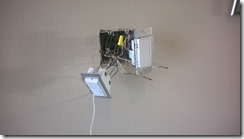Hmm, no neutral wire for my z-wave on/off switch, now what?
I tried to add another z-wave switch to my SmartThings network. I bought a on/off switch at Lowes (all the ‘works with Iris’ stuff you can use in your z-wave network), this is just a GE 1-way on/off z-wave switch, to connect to my outdoor lights so I can switch them on/off automatically with sunset/sunrise.
When I connected it to the 2 black wires which were used to the existing switch the lights didn’t come on. Although the led on the switch itself lighted up.
After some searching and reading the manual a little better I found out I needed to connect the neutral wire. Fortunately there is a neutral wire in this wall mount. I checked my study and that doesn’t have one. The weird thing is the z-wave dimmer works without the neutral wire.
So after wiring up the neutral wire the outdoor lights started working.
So I found some information on the SmartThings forum to explain what was going on.
No neutrals is a bad thing, unfortunately. You can use once of the switch types that don’t need a neutral, but they do have limitations.
First question: If these are three-way switches, there should be at least three wires. In the first box there should be a hot line (from the breaker/fuse box) and two wires (called traveler wires) going to the next box. At the second box there should also be three wires. The two traveler wires from the first box, and then one load wire leading to the light.
If this is what you have then you can look at Levitron which appears to have both switches and aux switches that do NO require neutrals. See this page: In particular, look at the setup in part 4B. This is what your setup should look like.
Second question: Why only Incandescent bulbs? The important thing to remember is that old “dumb” switches are simple mechanical devices. By flipping the switch you are mechanically connecting or disconnecting a circuit. The switch is nothing more than a path for power to move through.
However, a z-wave “smart” switch is an electronic device in and of itself. Yes it opens and closes the electrical circuit for your lights, but it also has a small radio built in as well as various other electronic components that control dimming, current state, etc. Because this is an electrical device it requires power all the time. This is why_most_ switches of this type need a neutral. The power used to “run the switch” comes from the hot, then goes out the neutral.
But some switches obviously don’t require a neutral… how do they operate then? They operate by allowing a small trickle of energy to move through the circuit. Enough to operate the switch, but not enough to make an incandescent bulb light up. These switches take advantage of the fact that incandescent’s need a (relatively speaking) high level of power before responding with light.
CFLs, on the other hand, take less juice and this constant trickle is enough to occasionally make them flicker or blink. Having a constant small level of juice probably isn’t very helpful to the ballast and other parts of the CFL either, potentially shortening their life considerably.
Similarly LEDs require a lot less juice too. Meaning that small trickle might be enough to make them come on at a dim level even when the switch is “off.” Theoretically if you have enough of a load of LED lights you might be able to get by without this switch lighting up your LEDs. For example, in one room of my house I have 4 LED lights each taking like 16 or so watts. That just might be enough to prevent them from lighting up (I don’t know for sure as I’ve got a switch with a neutral… just same it might be enough).
Okay… so this explanation ended up going long. Sorry ’bout that. Also, I hopefully I didn’t sound like I was talking down to you. Not sure how much you know or don’t know so thought I’d start with the basics.
In other words. if you don’t have a neutral wire, on/off could work with specific switches and regular light bulbs.
Comments
Comment by Steven on 2016-12-13 15:59:46 -0800
Thank you for posting. This posted saved me a call to the local Electrcian.
Comment by Steven on 2016-12-13 17:44:38 -0800
“… look at Levitron which appears to have both switches and aux switches that do NO require neutrals …”
Do you happen to have the model number for the Levitron switch you mention in the post?
